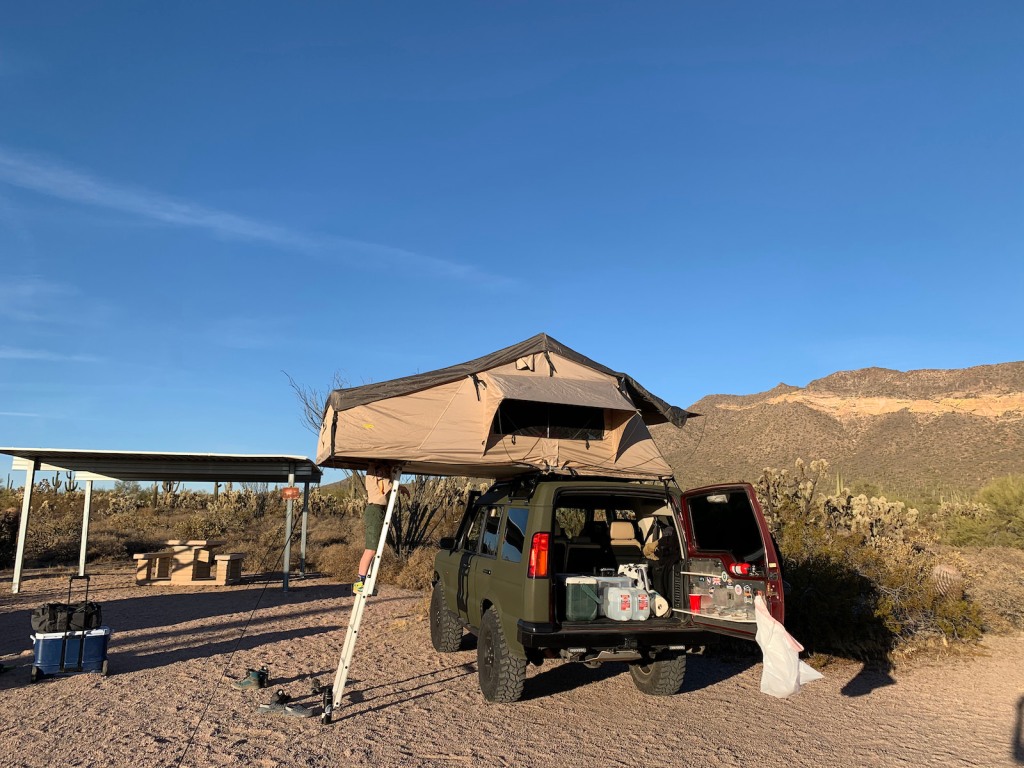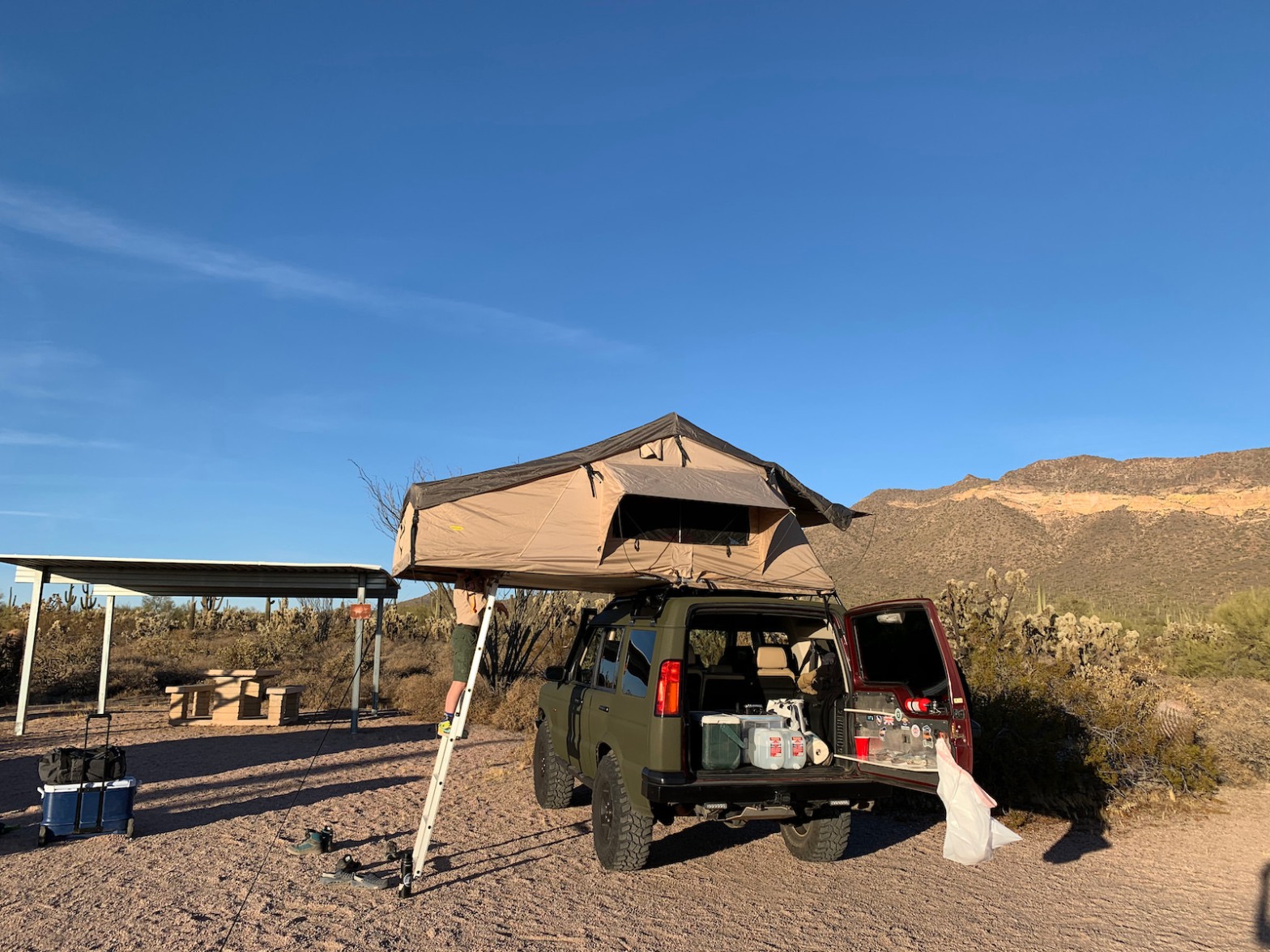I’m writing about this topic at a very particular moment in time. I’m still delirious from lack of sleep, sore from hanging on my truck’s roof rails like a monkey and downright grumpy from a horrible camping experience. But, I wanted to at least start this blog post now, while all of the benefits and drawbacks of a roof top tent are fresh in my mind.

Something You Should Know
Before we get too far, let me clarify something: I’m talking about soft-style roof top tents here, not the hard-shell style. I have no experience with those. In particular, I have the Smittybilt Overland XL. It’s a very large tent as far as roof top tents are concerned. Most of them are 2 person, but this is one is a 4 person. It’s also 2 feet longer than a standard soft-style roof top tent.
Also, in this blog post, I’m comparing the roof top tent to the standard ground tent. You know, the type of tent anyone would typically buy for “car camping”. My use of tents is usually centered around camping in remote camp spots near our vehicle, or Cub Scout campouts with the kids. I’m also assuming you know a thing or two about roof top tents so I won’t be describing what they are in great detail. You can get a brief introduction here.
Why I Bought a Roof Top Tent
As a family, we camp pretty often. Our kids love the outdoors. My wife and I enjoy escaping the desert heat for the cool pines in the summer. Last summer, with the pandemic and lock downs, one of the only things a family could do was camp. With all of our camping, I really wanted to upgrade my tent. I see these roof top tents on SUV’s all over my area and the idea really appealed to me.
You can get up off the ground, they pack up easily and the concept seemed to make sense. Interestingly, last summer, finding a roof top tent, new or used, was as difficult as finding hen’s teeth. Apparently, the pandemic made outdoor activity very popular and getting outdoor gear next to impossible. But, my wife spotted a fresh Facebook Marketplace listing last summer for a used Overland XL tent and we jumped on it. We were able to buy it for $850, which was a good deal, especially considering the high demand at the time.
I have used this tent 3 times. Our family camping adventures slowed shortly after obtaining the tent for various reasons. Those 3 camping trips, including the one I was on last night, where enough for me to form a solid impression of what is both good and bad about the roof top tent experience.
Roof Top Tents: The Good
You’re not sleeping on the ground.
It’s nice to be elevated off the ground, away from critters and bugs. Hearing squirrels, mice and whatever else, running around your tent at night can get annoying. The risk of a spider crawling in the tent door left open by your kid is also greatly diminished. I’m sure a determined bear could easily climb the ladder of a roof top tent and devour you, so I’m not sure it offers much protection there.
Easier to deploy than a ground tent.
On the face of it, unfolding a tent on your roof is simpler and quicker than messing with polls, guy lines and stakes. At first I thought this would be true and it sort of is, but you do trade one burden for another as we’ll see in the con section.
The views are nice up there.
Yes, because you’re so high up, especially on a lifted 4×4 truck, a roof top tent affords you some really nice views and a unique perspective. This is one aspect of a roof top tent I hand’t considered, but it was a nice surprise.
It’s warmer.
Maybe I’m wrong about this, but after camping in some cold weather, I feel like it was easier to stay warm in the roof top tent vs. the ground tent. It’s possible that because you’re not on the cold ground, and you have a thick mattress insulating the bottom, you stay a bit warmer.
No ground prep.
Because you’re up off the ground, you don’t have to worry about rocks, roots or anything else under your tent because the only thing that will be touching the ground is 2 thin ladder legs. You do however have to find level ground.
In the event of rain, you don’t have to worry about being flooded out.
When heavy rains come, you may find yourself digging a trench around your ground tent to keep water from flooding in. Not so with a roof top tent.
The kids love it.
Yeah, it’s that simple. The kids think it’s pretty cool. And, I get it, it is neat to be up high, perched on top of the truck.
I’m sure there are other good things about a roof top tents vs a ground tents, but those are the primary ones my tired brain can muster at this time. Now, we’ll get on the bad things about a roof top tent.
* Make sure you read all of them because there are some that are very important (especially the last point).
Roof Top Tents: The Bad
They’re expensive.
It won’t take long for you to realize that a roof top tent is considerably more expensive compared to a typical ground tent. A soft-style roof top tent will run you between $1000 to $3000. The hard-shell tents are even more expensive. Compare that to the price of a quality ground tent, something like the Gazelle T4, and you’re looking at a vast difference in cost.
Mounting a roof top tent is not always easy.
After paying the large sum of money required to join the roof top tent club, you still have to mount it to your vehicle. This may require a roof rack system that will run you another several hundred to thousands of dollars. You can easily find yourself $4000 in the hole for this tent.
But, it doesn’t end there. You have to get this heavy (150lbs in my case) tent onto the roof. For mine, it took 4 adults and some serious struggle to get it on the vehicle. Then, you have to bolt it down. This can be easy or hard depending on how your roof rack is setup. Once it’s up there, you won’t want to take it down any time soon. Many people just leave them on to avoid the pain of pulling it down and re-mounting it later.
Also, you’re probably not getting into the garage with the tent mounted.
They change the dynamics of your vehicle.
Strapping a 100-200 pound platform to the roof of your truck is not without consequence. The vehicle becomes top-heavy and you will notice it. Taking turns will feel a bit more tippy, you’ll hear wind noise and your fuel mileage will take a dive.
Depending on the height of your truck (or car), you might not be able to get into parking garages or the fast food drive through. My wife learned this the hard way. You always have to remember that it’s up there or you might destroy it.
Deploying and packing is still work.
You might not have to deal with stakes, guy lines and polls as much, but you still have to fold the tent down, tuck it all in, strap it, and then mount a huge, heavy cover over it every time you use it. You’ll find yourself climbing in open doors, hanging from the roof rack and trying to reach difficult areas to get the thing buttoned down. It is a bit easier than most ground tents, but not by much.
You’re tethered to your vehicle.
Want to go explore the area near your camp in your 4×4? You’ll have to re-pack your tent to do so and probably loose you camping spot. Because your tent is tied to your truck, you have to break down the tent anytime you need to drive somewhere. This really sucks.
Ladders are dangerous.
Going up and down a ladder can be dangerous, especially after you’ve had some adult beverages. Have to pee late at night? You have to find your footing on that ladder in the dark and work your way down. It can be a harrowing experience.
They become a sail in the wind.
This is what really did it for me while camping last night. We experience what I would describe as moderate wind. Nothing crazy, but it was pretty strong wind. Because we’re perched 9 feet high, the wind ravaged the tent. It was flapping and slapping in addition to causing the whole truck to sway side-to-side. I didn’t sleep at all.
I had to end our adventure at 5am and send my son to sleep in the truck while I broke down the tent in the dark while the wind whipped everything around, which made packing the tent extremely difficult. Now, my concern is this, had the wind be really strong, we would have been screwed because it would become nearly impossible to break that thing down in a real storm. This was a huge downer for me and the last straw.
Conclusion
Not everyone will have the same list of gripes as me, but I’m guessing the roof top tent owners out there can relate to most of these points. Because my list of cons outweighs the pros, I’m selling my roof top tent and going with the previously mentioned Gazelle T4 Plus instead. I don’t think the advantages of a roof top tent justify the down sides.
Update: Okay, I was going to sell it, but my kids guilted me into keeping it. We’ll see.
If you’re considering a soft-style roof top tent, take these things into consideration because it gets expensive and it might not be worth it for you. Of course, you can also go with a hard-shell tent, but they are limited on capacity and cost even more.


1 comment